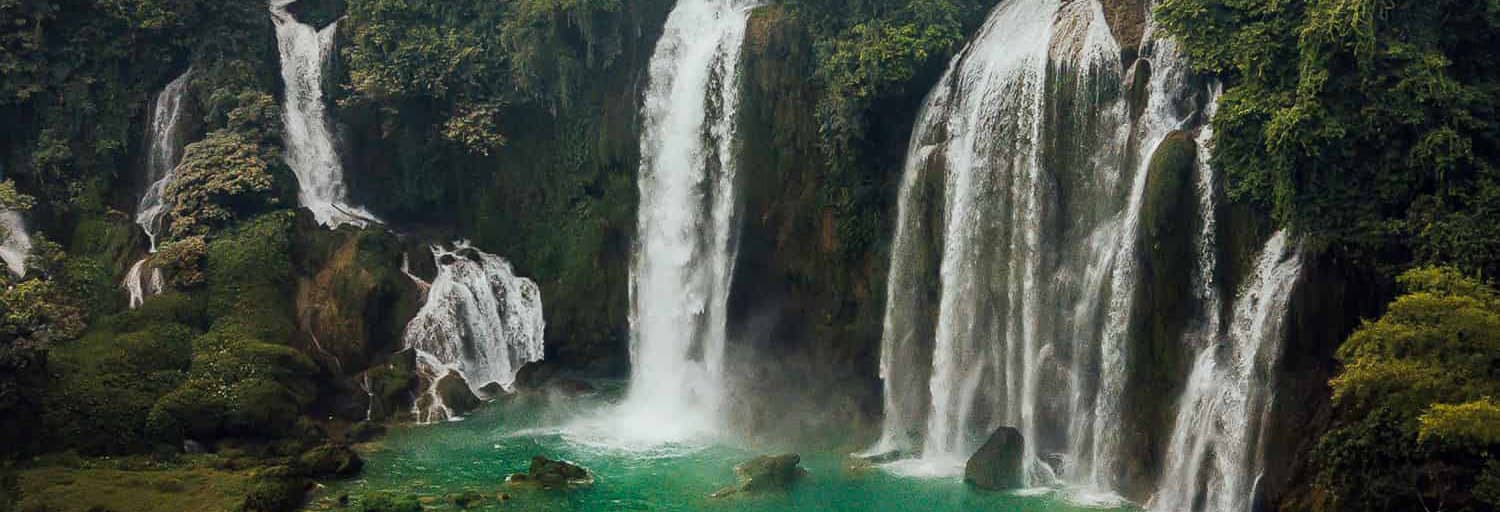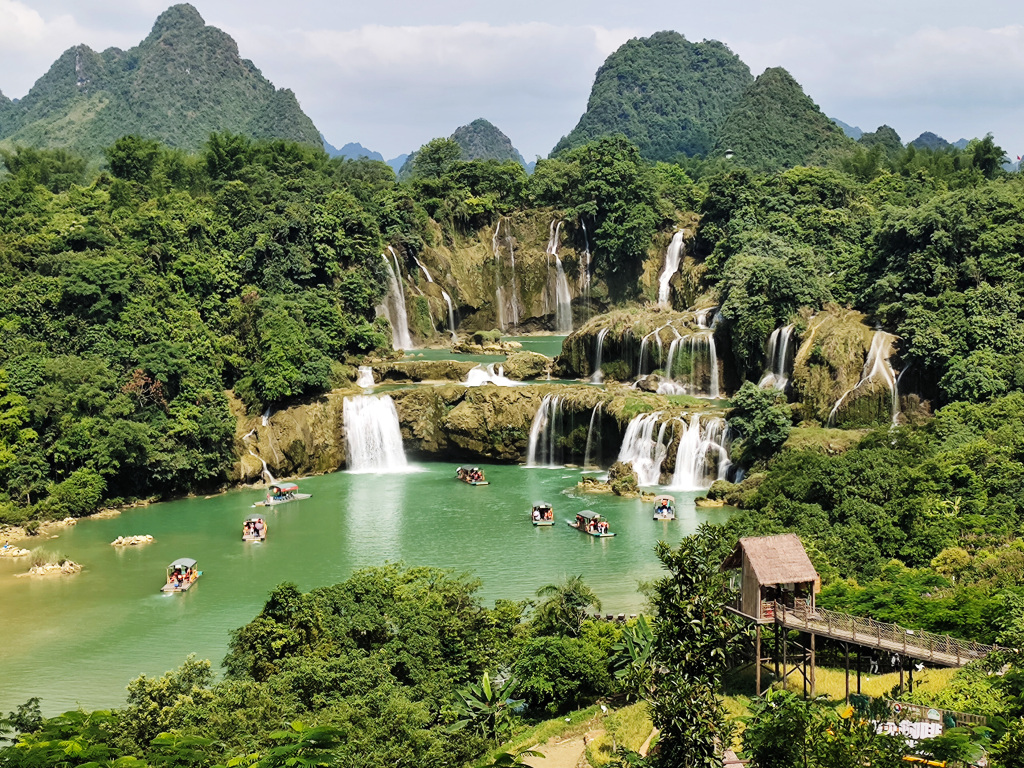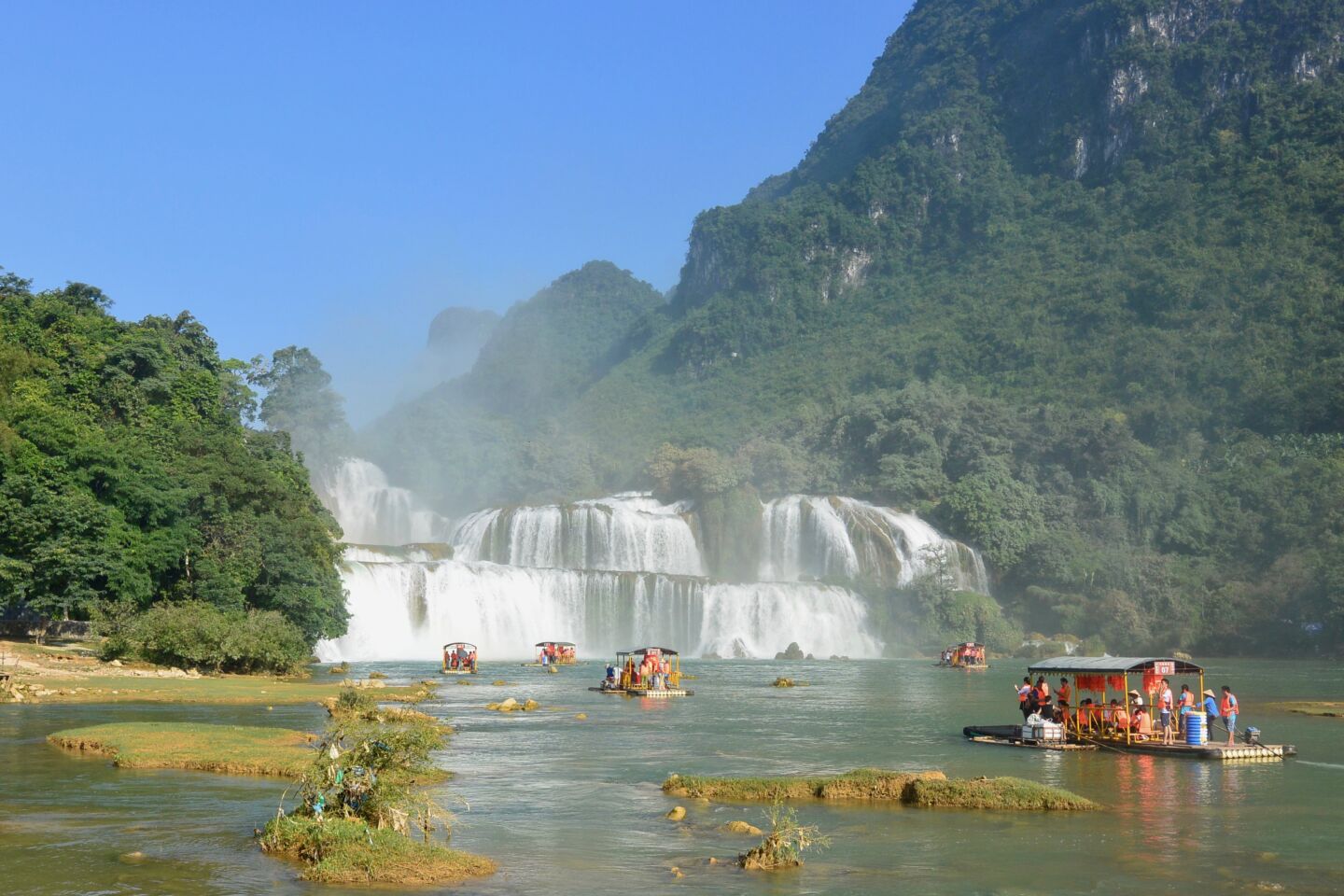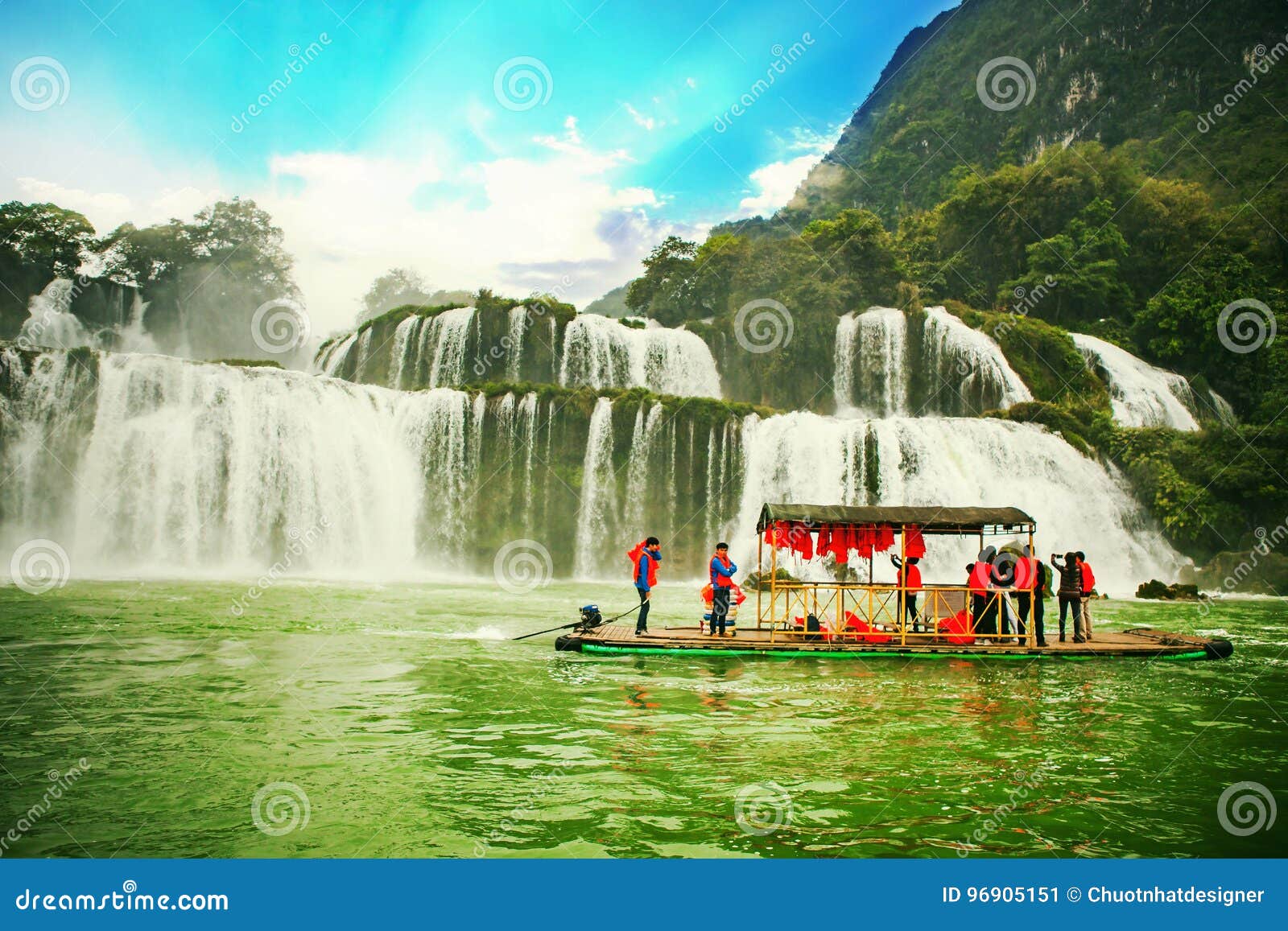Nestled in the lush landscapes of northern Vietnam, Ban Gioc Waterfall is a natural wonder that captivates the senses and ignites the spirit of adventure. This majestic cascade straddles the border between Vietnam and China, creating a breathtaking spectacle that has etched its name in the annals of natural beauty. In this comprehensive guide, we’ll delve into the enchanting world of Ban Gioc Waterfall, exploring its rich history, natural wonders, and the myriad of experiences it offers to visitors.
Ha Giang Loop: A Guide to the Scenic and Dangerous Motorbike Ride
Visiting Ban Gioc Waterfall

Accessing the Waterfall
To reach Ban Gioc Waterfall, visitors have several options:
- By Road: The most convenient way to access the waterfall is by road. From Hanoi, it’s about a 5-6 hour drive, passing through picturesque countryside landscapes and small villages. Alternatively, visitors can take a bus or hire a private car from nearby cities like Cao Bang or Lang Son.
- By Air and Road: For those short on time, flying to Cao Bang or Lang Son airports and then taking a short road trip to the waterfall area is an efficient option.
- Guided Tours: Many tour operators in Hanoi and nearby cities offer guided day trips or multi-day tours to Ban Gioc Waterfall, which can be a hassle-free way to experience this natural wonder.
Entrance Fees and Operating Hours
The waterfall is open to visitors throughout the year, with varying operating hours depending on the season. It’s advisable to check the current opening times and entrance fees before your visit.
Accommodation Options
While there are no accommodations within the immediate vicinity of the waterfall, visitors can find a range of options in nearby towns and villages, including homestays, guesthouses, and small hotels. Some popular options include Cao Bang City, Trung Khanh Town, and the villages surrounding the waterfall area.
Location of Ban Gioc Waterfall

Ban Gioc Waterfall is situated in the Trung Khanh district of Cao Bang province, in the far northeastern region of Vietnam. It lies along the border with China, with the waterfall spanning across the Quay Son River, which forms a natural boundary between the two countries.
Geographical Location
- Coordinates: 22°53′26″N 106°38′51″E
- Elevation: Approximately 300 meters (984 feet) above sea level
- Distance from Hanoi: Approximately 330 kilometers (205 miles)
Surrounding Landscape
The waterfall is nestled in a verdant valley surrounded by lush karst limestone mountains and dense forests. The area is part of the UNESCO-recognized Cao Bang Geopark, renowned for its exceptional geological heritage and diverse landscapes.
History of Ban Gioc Waterfall

Ancient Origins
Ban Gioc Waterfall has been a part of the local landscape for centuries, with its origins rooted in the geological history of the region. According to local legends, the waterfall was formed by the mythical dragon’s tail, which carved its way through the rugged terrain, leaving behind a breathtaking cascade.
Border Demarcation
The waterfall gained historical significance when it became the natural boundary between Vietnam and China during the demarcation of borders in the late 19th century. This unique geographical feature has since played a pivotal role in shaping the cultural and political dynamics of the region.
Tourism Development
While Ban Gioc Waterfall has long been revered by local communities, it wasn’t until the late 20th century that it gained recognition as a major tourist attraction. With increased accessibility and promotional efforts by the Vietnamese government, the waterfall has become a popular destination for both domestic and international visitors.
Formation of Ban Gioc Waterfall

Geological Processes
The formation of Ban Gioc Waterfall is a testament to the power of nature and the relentless forces that shape our planet. The waterfall’s distinctive appearance can be attributed to the erosion and dissolution of limestone and dolomite rocks over millions of years.
Erosion by Water
The Quay Son River, which flows through the region, has played a crucial role in the formation of the waterfall. Over time, the river’s continuous flow has eroded the limestone and dolomite rocks, creating a series of cascades and plunge pools.
Tectonic Activity
The region’s tectonic activity, including the uplifting and folding of rock layers, has also contributed to the waterfall’s unique shape and structure. This geological process has created the dramatic vertical drop that characterizes Ban Gioc Waterfall.
Features of Ban Gioc Waterfall

Dimensions and Structure
Ban Gioc Waterfall is a true marvel, with a total width of approximately 300 meters (984 feet) and a height of 53 meters (174 feet). It comprises three main cascades, each with its unique character and beauty:
- Main Cascade: The largest and most impressive cascade, plunging from a height of 53 meters (174 feet) with a width of around 150 meters (492 feet).
- Left Cascade: A smaller cascade located to the left of the main waterfall, with a height of around 35 meters (115 feet).
- Right Cascade: Another smaller cascade on the right side, with a height of approximately 25 meters (82 feet).
Water Flow and Volume
The water flow of Ban Gioc Waterfall varies throughout the year, with the highest volume typically occurring during the rainy season from May to September. During this period, the waterfall transforms into a raging torrent, thundering down the cascades and creating a mesmerizing spectacle of power and beauty.
Surrounding Landscape
The natural surroundings of Ban Gioc Waterfall are equally breathtaking. Lush green forests, karst limestone mountains, and picturesque valleys create a scenic backdrop that enhances the waterfall’s allure. Visitors can immerse themselves in this natural wonderland and explore the countless hiking trails and viewpoints that offer unparalleled vistas.
Local Culture and Traditions near Ban Gioc Waterfall

Indigenous Communities
The region surrounding Ban Gioc Waterfall is home to various ethnic minority groups, each with their unique cultural traditions and ways of life. Among the most prominent communities are the Tay, Nung, and H’mong ethnic groups.
Traditional Crafts
Local artisans have mastered various traditional crafts, such as weaving, pottery, and woodcarving. Visitors can explore local markets and villages to witness these age-old techniques and purchase handmade souvenirs and handicrafts.
Festivals and Celebrations
Throughout the year, the region celebrates various festivals and cultural events that offer a glimpse into the rich heritage of the local communities. Some notable events include the Nung ethnic group’s New Year celebrations, the Tay ethnic group’s Long Tong (Going to the Field) festival, and the H’mong ethnic group’s traditional weddings.
Wildlife around Ban Gioc Waterfall

Biodiversity Hotspot
The area surrounding Ban Gioc Waterfall is a biodiversity hotspot, home to a diverse array of plant and animal species. The dense forests, limestone mountains, and pristine waterways provide a haven for numerous species, many of which are endemic to the region.
Flora and Fauna
- Flora: The forests around the waterfall are dominated by evergreen and deciduous trees, including species such as Chinese banyan, wild ginger, and various orchid varieties.
- Fauna: The region is home to a rich array of wildlife, including mammals like the François’ leaf monkey, Owston’s civet, and Asian black bear, as well as numerous bird species, reptiles, and amphibians.
Conservation Efforts
To protect the rich biodiversity of the area, the Vietnamese government has established several nature reserves and protected areas near Ban Gioc Waterfall. These efforts aim to preserve the delicate ecosystems and ensure the long-term survival of the region’s unique flora and fauna.
Best Time to Visit Ban Gioc Waterfall

Peak Season (May to September)
The rainy season, which typically runs from May to September, is considered the peak season for visiting Ban Gioc Waterfall. During this period, the waterfall is at its most powerful and dramatic, with the cascades thundering down at their highest volume.
- Pros: Witnessing the waterfall in its full glory, lush green surroundings, and cooler temperatures.
- Cons: Increased likelihood of rain, higher visitor numbers, and potentially slippery trails.
Dry Season (October to April)
The dry season, spanning from October to April, offers a different perspective on Ban Gioc Waterfall. While the water flow may be reduced, visitors can enjoy a more serene and tranquil experience.
- Pros: Fewer crowds, better visibility for photography, and the opportunity to explore the surrounding area without the hindrance of heavy rainfall.
- Cons: Reduced water flow, less dramatic waterfall display, and drier landscape.
Overall, the best time to visit Ban Gioc Waterfall ultimately depends on personal preferences. Whether you prefer the raw power of the waterfall during the rainy season or the peaceful ambiance of the dry season, each period offers a unique and unforgettable experience.
Activities at Ban Gioc Waterfall

Sightseeing and Photography
One of the main activities at Ban Gioc Waterfall is sightseeing and photography. Visitors can marvel at the majestic cascades, capture stunning images of the waterfall and surrounding landscapes, and immerse themselves in the natural beauty of the area.
Boat Tours
Boat tours are a popular way to experience Ban Gioc Waterfall up close. Visitors can take a boat ride along the Quay Son River, which flows through the waterfall, providing a unique vantage point to admire the cascades and feel the mist on their faces.
Hiking and Trekking
For outdoor enthusiasts, hiking and trekking opportunities abound near Ban Gioc Waterfall. Various trails lead through the lush forests, up the limestone mountains, and offer panoramic views of the waterfall and its surroundings. It’s a great way to connect with nature and explore the region’s hidden gems.
Swimming and Picnicking
During the dry season when water levels are lower, visitors can enjoy swimming in the plunge pools at the base of the waterfall. Picnicking by the riverside, surrounded by the sounds of nature, is also a popular activity for families and groups looking to relax and unwind.
Cultural Immersion
Exploring the nearby villages and interacting with the local communities is a fantastic way to immerse yourself in the culture and traditions of the region. From sampling traditional cuisine to participating in local festivities, there are plenty of opportunities to learn about the rich heritage of the ethnic minority groups that call this area home.
Conservation Efforts for Ban Gioc Waterfall
Protected Areas
To safeguard the natural beauty and ecological significance of Ban Gioc Waterfall, the Vietnamese government has designated the surrounding area as a protected zone. This status ensures that development activities are regulated, and conservation efforts are prioritized to maintain the integrity of the ecosystem.
Environmental Education
Educating visitors about the importance of conservation and sustainable practices is key to preserving Ban Gioc Waterfall for future generations. Interpretive signage, guided tours, and outreach programs help raise awareness about the fragility of the environment and the need to protect it.
Community Involvement
Engaging local communities in conservation initiatives is crucial for the long-term success of preservation efforts. By involving residents in eco-friendly practices, promoting responsible tourism, and supporting sustainable livelihoods, the impact of human activities on the ecosystem can be minimized.
Wildlife Protection
Protecting the diverse flora and fauna around Ban Gioc Waterfall is a top priority for conservationists. Monitoring wildlife populations, enforcing anti-poaching measures, and restoring habitats are essential strategies to ensure the continued survival of endangered species and maintain biodiversity in the region.
Sustainable Tourism Practices
Promoting sustainable tourism practices, such as waste management, energy conservation, and responsible visitor behavior, is essential for minimizing the environmental footprint of tourism activities around Ban Gioc Waterfall. By encouraging eco-conscious choices, the impact on the ecosystem can be reduced while still allowing visitors to enjoy this natural wonder.
Conclusion
In conclusion, Ban Gioc Waterfall stands as a testament to the awe-inspiring power of nature and the intricate beauty of our planet’s landscapes. From its tumultuous cascades to the serene plunge pools, the waterfall captivates visitors with its grandeur and charm. The surrounding region, rich in cultural diversity and biodiversity, adds another layer of fascination to this natural wonder.
As visitors flock to witness the majesty of Ban Gioc Waterfall, it is imperative to remember the importance of conservation and sustainable practices. By protecting the delicate ecosystems, engaging with local communities, and promoting responsible tourism, we can ensure that this magnificent waterfall remains a pristine sanctuary for generations to come. Let us cherish and preserve Ban Gioc Waterfall, not just as a tourist destination, but as a symbol of our commitment to safeguarding the natural world.


